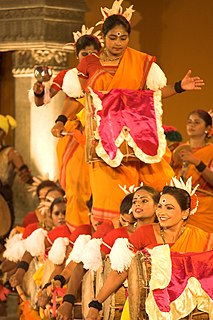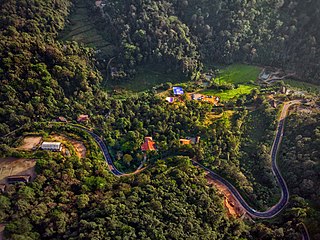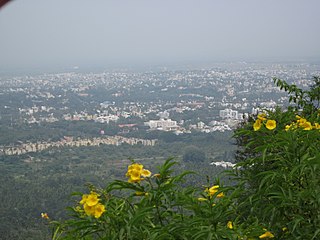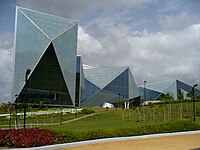
Karnataka is a state in South India. The state is in the south western region of India. It was formed on 1 November 1956, with the passage of the States Reorganisation Act. Originally known as the State of Mysore, it was renamed Karnataka in 1973. The state corresponds to the Carnatic region. Its capital and largest city is Bangalore.

Mysore, officially Mysuru, ಮೈಸೂರು, is a city in the southern part of the state of Karnataka, India. Mysuru city is geographically located between 12° 18′ 26″ north latitude and 76° 38′ 59″ east longitude. It is located at an altitude of 770 m (2,530 ft) above mean sea level.

The National Institute of Engineering (NIE) is a private engineering college located in Mysore, Karnataka, India. It was established in 1946 and granted autonomy in 2007 from Visvesvaraya Technological University.

Mysuru District is an administrative district located in the southern part of the state of Karnataka, India. It is the administrative headquarters of Mysore Division.Chamarajanagar District was carved out of the original larger Mysore District in the year 1998. The district is bounded by Chamrajanagar district to the southeast, Mandya district to the east and northeast, Kerala state to the south, Kodagu district to the west, and Hassan district to the north.

Mysore division, officially Mysuru division, is an administrative division in the southern Indian state of Karnataka. It is one of four administrative divisions in Karnataka, with others being Bangalore division, Belgaum division, Gulbarga division. Mysore division comprises eight districts of Karnataka, namely, Chamarajanagar, Chikmagalur, Dakshina Kannada, Hassan, Kodagu, Mandya, Mysore and Udupi district. The city of Mysore is the administrative headquarters of the division. Mysore division covers parts of historical Old Mysore region and southern part of Coastal Karnataka.The total area of the division is 43,503 sq.km. The total population as of 2011 census is 12,563,598.

Gokak is a taluka headquarters in the Belgaum district of Karnataka state, India. It is located around 70 km from Belgaum at the confluence of two rivers, the Ghataprabha and the Markandeya. The population of the city is according to 2011 census is approximately 150,773. Gokak city has second highest GDP in the district of Belgaum after Belgaum city. The common language is Kannada.

Karnataka Rajyotsava or Kannada Rajyotsava or Kannada Day, also known as Karnataka Formation Day or Karnataka Day, is celebrated on 1 November of every year. This was the day in 1956 when all the Kannada language-speaking regions of South India were merged to form the state of Karnataka.

Kushalanagar is a city located in the Kodagu district of Karnataka state of India. Surrounded by Kaveri river, it is the gateway of the Coorg district. It also serves as the headquarters of Kushalanagar Taluk. By population, Kushalanagar is the third largest town in the district after Madikeri and Virajpet. Kushalnagar is an important commercial centre in Kodagu.
'Economy of South India after independence in 1947 conformed to a socialist framework, with strict governmental control over private sector participation, foreign trade and foreign direct investment (FDI). Through 1960–1990, South Indian economies experienced mixed economic growth. In the 1960s, Kerala achieved above-average economic growth, while Andhra Pradesh's economy declined during this period. Similarly, Kerala experienced an economic decline in the 1970s while the economies of Tamil Nadu, Andhra Pradesh, and Karnataka consistently exceeded national average growth rates after 1970. Andhra Pradesh, Tamil Nadu and Karnataka were noted by some to be more reform-oriented in terms of economic policy when compared to other Indian states. Over the last decade South India has grown at 8% annually. Future economic growth will be shackled by a relatively low proportion of the active age population to the number of dependents.

Karnataka is one of the highest economic growth states in India with an expected GSDP growth of 8.2% in the 2010–11 fiscal year. The total expected GSDP of Karnataka in 2010–2011 is about ₹2719.56 billion. Karnataka recorded the highest growth rates in terms of GDP and per capita GDP in the last decade compared to other states. In 2008–09, the tertiary sector contributed the most to GSDP, followed by the secondary sector, and the primary sector.
The software industry in Karnataka state in India has become one of the main pillars of the state's economy. Karnataka stands first among all the states of India in terms of revenue generated from software exports, accounting for 41.6% of all software exports from the country during the financial year of 2018–19. Karnataka's capital city Bangalore has the sobriquet of Silicon Valley of India, with total IT exports worth $45 billion during the financial year 2016–17, employing 10 lakh people directly and 30 lakh indirectly. Though most software companies are located in Bangalore, some have settled in other cities like Mysore, Mangalore, Belgaum and Hubli in Karnataka. The infrastructure required for setting up software industries in Karnataka is provided by STPI. The software industry in Karnataka includes companies dealing with various fields like telecommunication, banking software, avionics, database, automotive, networking, semiconductors, mobile handsets, internet applications and business process outsourcing.
Mysore Sandal Soap is a brand of soap manufactured by the Karnataka Soaps and Detergents Limited (KSDL), a company owned by the government of Karnataka in India. This soap has been manufactured since 1916, when Krishna Raja Wadiyar IV, the king of Mysore, set up the Government Soap Factory in Bangalore. The main motivation for setting up the factory was the excessive sandalwood reserves that the Mysore Kingdom had, which could not be exported to Europe because of the First World War. In 1980, KSDL was incorporated as a company by merging the Government Soap Factory with the sandalwood oil factories at Shimoga and Mysore. Mysore Sandal Soap is the only soap in the world made from 100% pure sandalwood oil. KSDL owns a proprietary geographical indication tag on the soap, which gives it intellectual property rights to use the brand name, to ensure quality, and to prevent piracy and unauthorised use by other manufacturers. In 2006, Mahendra Singh Dhoni, the Indian cricketer was selected as the first brand ambassador of the Mysore Sandal Soap.

Harohalli is a village in the southern state of Karnataka, India. It is located in the Harohalli also kanakpura taluk of Ramanagar district in Karnataka.

The Karnataka Fire and Emergency Services department is a department of the Government of Karnataka that is the foremost disaster management body in Karnataka, India.

Bangalore, officially known as Bengaluru, is the capital and the largest city of the Indian state of Karnataka. It has a population of more than 8 million and a metropolitan population of around 11 million, making it the third most populous city and fifth most populous urban agglomeration in India. Located in southern India on the Deccan Plateau, at a height of over 900 m (3,000 ft) above sea level, Bangalore is known for its pleasant climate throughout the year. Its elevation is the highest among the major cities of India.

Hootagalli or Hutagalli is a city and a Suburb of Mysore, situated in Mysuru metropoltian area ಮೈಸೂರು ಜಿಲ್ಲೆ of Karnataka, India. Hootagalli is located in the outskirts of the city of Mysuru and forms a continuous urban area. Hootagalli city municipal council consists of previous census towns of Hinkal, Hootagalli and Gram Panchyats of Koorgalli and Belavadi totally covering an area of 28.48 square km. In November 2020, the government of Karnataka approved the formation of Hootagalli City Municipal Council by merging four gram panchayats. The initial plan was to include it with MCC to form Greater Mysuru City Corporation (BMMP) however, due to MCC disputing the proposal, a separate body was created. According to 2011 census, the city municipal council has combined population of 56,876. On November 26, 2020, a gazetted notification was passed making the CMC official.

Mysuru Local Planning Area is the metropolitan area limit defined in City Development Plan 2031 by Mysore Urban Development Authority. Mysuru Planning Area is divided into 45 planning districts spanning across the Taluks of Mysore, Nanjangud and Srirangapatna of Mandya district. As per City Development Plan 2031, this metropolitan area covers 509sq.km of area and has a population of 1,696,577.

Vijayanagar and Hebbal are two areas of Mysore city in India. the growth of technology-related industry in the first decade of the 21st century has resulted in the city emerging as the second largest software exporter in the state of Karnataka, next to Bangalore.

Hebbal Lake is a lake in the city of Mysore, India.

KRS Nisarga Badavane is a mega housing project by Karnataka Housing Board formed in northwestern Mysuru. KRS Nisagra was named as it is right next to the Krishna Raja Sagara - KRS dam location. The layout has 6,309 sites, 207 houses, 18 civic amenity site, 12 commercial complexes and 54 parks.





















